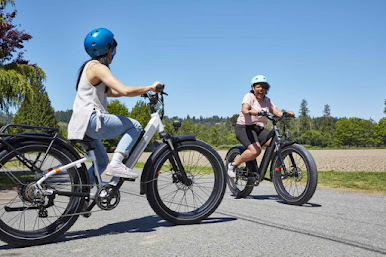What are Electric Bikes with Suspension and How do They Work?
Electric bikes, also known as e-bikes, have been gaining in popularity in recent years. These bikes are powered by an electric motor and battery, allowing riders to travel further and with less effort than a traditional bike. One popular feature of some e-bikes is suspension, which can improve the ride and handling of the bike. In this blog post, we will explore what electric bikes with suspension are and how they work.
First, let's define suspension. Suspension refers to a system of springs, shocks, and other components that are designed to absorb shocks and vibrations from the road or trail. This can make the ride smoother and more comfortable for the rider, as well as improving handling and control.
Electric bikes with suspension have a similar setup to traditional bikes with suspension, but with the added benefit of an electric motor. The motor can help to offset the added weight of the suspension system, making it easier to pedal and maneuver the bike.
There are several different types of suspension systems that can be found on electric bikes, including:
1. Front suspension: This type of suspension is located on the front fork of the bike and helps to absorb shocks and vibrations from the front wheel. It is typically found on mountain bikes and other off-road e-bikes.
2. Rear suspension: Rear suspension is located on the rear frame of the bike and helps to absorb shocks and vibrations from the rear wheel. It is also commonly found on mountain bikes and other off-road e-bikes.
3. Full suspension: Full suspension bikes have both front and rear suspension systems. This provides the most comprehensive shock absorption and is typically found on high-end mountain bikes and other high-performance e-bikes.
The suspension system on an electric bike works by compressing and rebounding as the bike encounters bumps and obstacles on the road or trail. The system is made up of several components, including:
1. Springs: Springs are the primary component of a suspension system and provide the majority of the shock absorption. They can be made from a variety of materials, including steel and titanium.
2. Dampers: Dampers, also known as shocks, help to control the motion of the springs and prevent them from bouncing too much. They use hydraulic or pneumatic fluid to slow down the motion of the spring.
3. Linkages: Linkages connect the springs and dampers to the bike frame and allow them to move and compress as needed.
When a rider encounters a bump or obstacle, the suspension system compresses, absorbing the shock and preventing the rider from feeling the full impact. As the bike moves past the obstacle, the suspension system rebounds, returning to its original position and preparing for the next obstacle.
In addition to improving ride comfort and handling, suspension can also help to extend the life of the bike and its components. By absorbing shocks and vibrations, suspension can reduce the stress and wear on the frame, wheels, and other components, helping to prevent damage and prolonging the life of the bike.
In conclusion, electric bikes with suspension are a popular choice for riders looking for a comfortable, smooth ride with improved handling and control. With several different types of suspension systems available, riders can choose the one that best suits their needs and riding style. Whether you're cruising around town or hitting the trails, an electric bike with suspension can make your ride more enjoyable and less stressful on your body.


.jpg)
Comments
Post a Comment